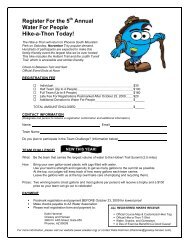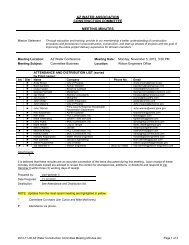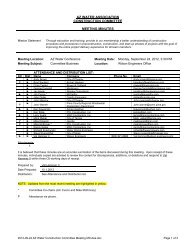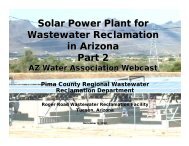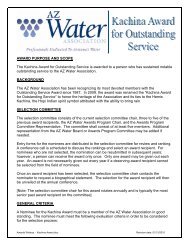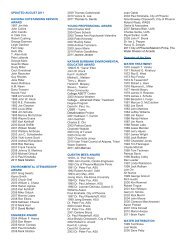Request For Sale (Rfs 08-07) - AZ Water Association
Request For Sale (Rfs 08-07) - AZ Water Association
Request For Sale (Rfs 08-07) - AZ Water Association
You also want an ePaper? Increase the reach of your titles
YUMPU automatically turns print PDFs into web optimized ePapers that Google loves.
Determining<br />
Confined Space Training Requirements<br />
By John W. Bannen,<br />
Workplace Safety Specialists<br />
<strong>AZ</strong> WATER ASSOCIATION 14 January 2009<br />
Entering and working in confined spaces is<br />
established as a hazardous activity and effective<br />
training needs to be accomplished as a means to<br />
help protect employees from these hazards. Some<br />
of the most frequently posed questions to<br />
consultants and training organizations have to do<br />
with what is needed in conducting training and<br />
how often the training is needed. Needs can be<br />
broken into the two categories of regulatory<br />
mandated and employer directed. Accomplishing<br />
training in accordance with federal, state or local<br />
requirements requires review of the published<br />
standards and general familiarity with formal<br />
language used in the rules and regulations.<br />
Employer directed training must meet the<br />
regulatory standards but will often incorporate<br />
additional requirements that create a site-specific,<br />
more effective training plan. After evaluation of<br />
the confined space training needs, a<br />
determination of what type of training must be<br />
completed. As confined space training is a very<br />
common safety topic, there is training available in<br />
many different medias. The table on the next<br />
page will address the pros and cons of these<br />
different types of training.<br />
OSHA states, “The employer shall provide training<br />
so that all employees whose work is regulated by<br />
this section acquire the understanding, knowledge,<br />
and skills necessary for the safe performance of the<br />
duties assigned under this section.” (29 CFR<br />
1910.145(g)(1). The training requirements for<br />
confined space entry operations are straight<br />
forward. After an employer has determined there<br />
are permit required confined spaces and whether or<br />
not employees will be allowed to enter these<br />
confined spaces, an appropriate training plan can be<br />
formulated. Employers do have the option of<br />
restricting employees from entering permit required<br />
confined spaces. If this is the determination made<br />
by the employer, there still remains a responsibility<br />
of the employer to make sure employees are trained<br />
at an awareness level about confined spaces in order<br />
to prevent employees from entering and working in<br />
these spaces. This training, sometimes considered<br />
an awareness level training, should address the<br />
following: the company’s policy and confined space<br />
program limiting the employees’ access to confined<br />
spaces and their hazards; recognizing the confined<br />
space warning and identification signs; changes in<br />
use or configuration of non-permit spaces could<br />
require that the space be reclassified as a permit<br />
required space; and finally procedures that address<br />
employees of other companies entering and<br />
working in the permit required confined spaces of<br />
the employer. When an employer determines<br />
employees will enter and work in permit required<br />
confined spaces, 29 CFR 1910.146(g) clearly<br />
outlines the requirements and specifics that must be<br />
addressed during training.<br />
Employers that have established a need for a<br />
confined space program and accompanying<br />
employee training typically add additional<br />
requirements into the confined space training<br />
curriculum. These additional items are used to help<br />
create a more effective and site-specific training.<br />
While the regulatory requirements for training<br />
items address confined space entry operations in a<br />
general language, a company specific plan can<br />
thoroughly address specific hazards and work<br />
practices. An example of this is developing a sitespecific,<br />
hazard specific confined space entry<br />
permit or using photographs of the company’s<br />
confined spaces to clearing communicate the<br />
specific hazards employees may encounter during







